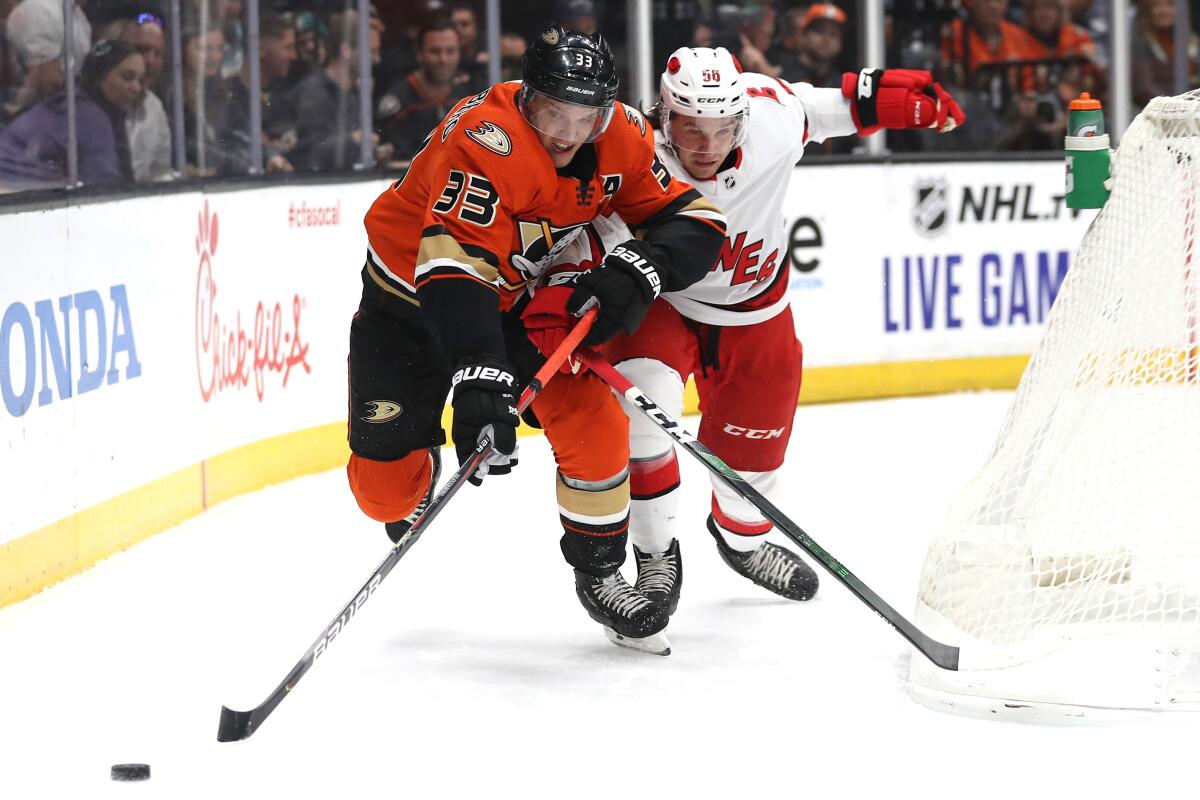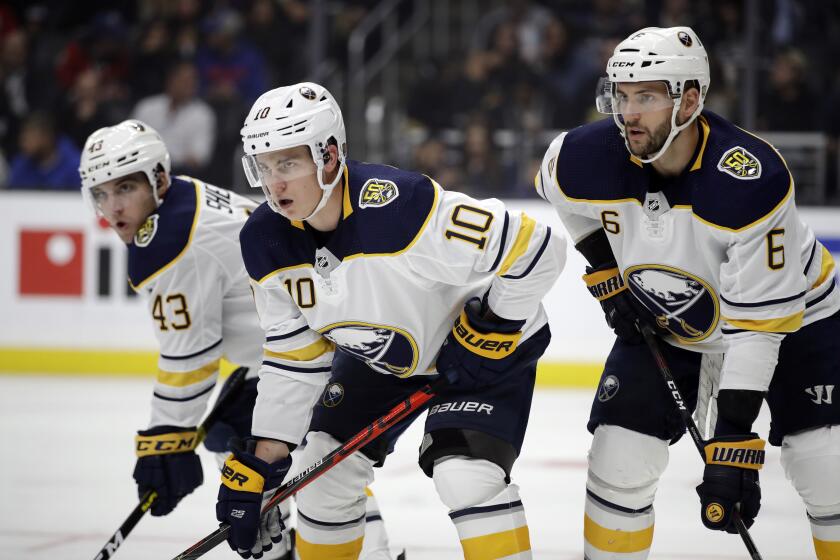Ducks’ luck has increased as puck movement has improved

- Share via
Because of their mascot, there never seems to be a shortage of puns or plays on words with which to describe the Ducks. They could be staying afloat or failing to take flight. Quacking with delight and waddling away with wins.
This season though, in the system of new coach Dallas Eakins, there has been one figure of speech that fits just right. There have been moments the Ducks’ puck movement has resembled a flock in perfect formation, intrinsic passing sequences derived as much from instinct as instruction.
“There’s a lot more room out there when you play that way,” forward Jakob Silfverberg said. “You try and spread them out. It allows you to play with a lot more puck control and enter their zone skating it in rather than dumping and chasing.”
The Ducks haven’t been a volume-shooting team, averaging the sixth-fewest shots in the NHL with 28.6 per game entering Tuesday. But their ability to produce dizzying spells of offense — in which the puck is whipped between waves of players weaving around the ice — has helped them exceed early season expectations with a 6-4-0 start.
Full-ice passing sequences factored into all four goals the Ducks scored Friday in a 4-2 win over Carolina. Even in a 2-1 loss to Calgary on Sunday, it allowed them to dominate in possession and chances down the stretch. During a 6-1 loss at Nashville on Tuesday, it was too often missing — leading to a rare blowout loss.
Flames goaltender Cam Talbot fends off a spirited comeback attempt in the final minutes by the Ducks, who lose at home for the first time this season.
“We’re able to do that when we get close together offensively, especially with our three forwards,” Eakins said Sunday. “Those guys can move that puck and do some very fine things with it.”
This is all affirmation of the system Eakins is trying to put in place. Players say his message has emphasized the utilization of speed and space, spreading out defenses to then slice them apart.
“Dallas allows us to be patient and not rush over,” Silfverberg said. “He tells the guys that get the puck on the half-boards, rather than just kind of slap at it, take it and protect it for half a second. Look up. There’s usually a lot of space on the far side.”
That’s what happened on Silfverberg’s goal Sunday.
The rush started with a neutral-zone give-and-go between defenseman Josh Manson and winger Rickard Rakell. Manson then carried the puck down the right wing and across the Flames’ blue line. He fed his defense partner Hampus Lindholm in the middle of the ice, and Lindholm got the puck to Silfverberg on the left wing with a back-hand feed.
Stretched out of place, the Flames had left Silfverberg all alone. In one motion, he collected the puck and fired inside the post.
“It’s easier playing that way too,” Silfverberg added. “You don’t have to chip-and-chase as much. You can control the pace.”
There is a level of natural creativity required. The Ducks forwards quickly have blended chemistry and confidence to create moments of puck-moving brilliance and benefited from savvy play by defensemen now encouraged to jump into the play.
The Buffalo Sabres remember riding a 10-game winning streak to the top of the NHL last November only to fall apart, so they’re not gloating about where they’re sitting.
“We have some freedom now for our D to get involved,” veteran defenseman Cam Fowler said. “When teams have to take into account the defensemen, it opens up some ice for our forwards. I think all five guys on the ice feel like they can play a role offensively. I think that’s something that we lacked last year. It creates more time and space for our guys. I think you’re seeing the result of that.”
Eakins still wants to see his offense, which ranks only 25th in the league in scoring with 2.40 goals per game, click more consistently and finish more chances. For example, the Ducks took two periods to find their rhythm against the Flames, leaving themselves too little time to mount a rally.
“In the first period, it seemed like there was a lacrosse ball on the ice for both teams,” Eakins said. “[The puck was] bouncing all over the place.”
At their best, however, the Ducks can make passing look like an art form, able to streak down the ice with the synchronicity of birds soaring through the sky.
“It’s a fun way to play,” Silfverberg said. “It’s sort of the way most teams play these days. And you create a lot of offense by doing that.”
More to Read
Go beyond the scoreboard
Get the latest on L.A.'s teams in the daily Sports Report newsletter.
You may occasionally receive promotional content from the Los Angeles Times.









